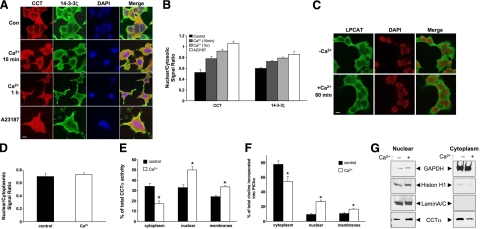Figure 1.
Ca2+ stimulates nuclear translocation of CCTα and 14-3-3ζ in lung epithelia. A–D) MLE cells were incubated in serum-free medium with (+Ca2+) or without (−Ca2+) calcium chloride (1.0 mM) for various times. Cells were also exposed to A23187 (10 nM) for 10 min. Cells were then fixed and processed for immunofluorescent staining using either 14-3-3ζ or CCTα primary antibodies followed by incubation with Alexa 488/568 secondary antibodies (Invitrogen) and DAPI (Thermo Scientific) (A, B), or LPCAT primary antibodies followed by incubation with FITC (Sigma, St. Louis, MO, USA) and DAPI antibodies (C, D). Subcellular localization of proteins was monitored using a confocal microscope. Bars represent quantitative measurements of relative nuclear/cytosolic intensities (B, D). E, F) Cells stimulated with (θ) or without (ν) calcium chloride (0.4 mM) were harvested after 10 min, and cytosolic, nuclear, and membrane fractions were isolated and processed for CCT activity (E) and PtdCho synthesis (F). Data represent values expressed as percentage of total enzyme activity (D) or [3H]-choline incorporation into cells (E). G) Subcellular fractions were confirmed using nuclear and cytosolic markers and correlated with CCTα translocation. Data in each panel represent n = 3 separate experiments. *P < 0.05 vs. control. Scale bars = 10 μm.

